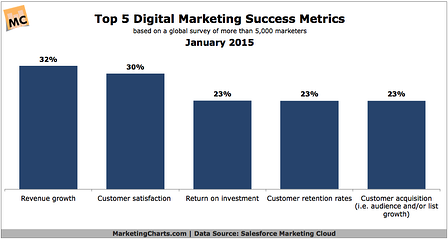CEO Blog - Advice for CEOs on growth and scaling
Key Marketing Metrics for Revenue and Profit Growth

 Marketing metrics are at the essence of any business program. Key marketing metrics indicate the heights to which revenues will soar or the depths to which fortunes will plummet—as a result of your strategic business efforts.
Marketing metrics are at the essence of any business program. Key marketing metrics indicate the heights to which revenues will soar or the depths to which fortunes will plummet—as a result of your strategic business efforts.
Long gone are the days when conjecture, hypothesis and “gut feel” were acceptable ways to gauge business success. The digital explosion, while requiring us to be even more dialed into a dialog with our consumers, has also given rise to a raft of new tools that help us analyze the quality of these interactions. Such information can offer amazingly keen insight into how well our overall marketing strategy is working, as well as to identify the focus areas for business growth.
Idenitfy Key Marketing Metrics for Your Business
Where to start? Most companies have hundreds of unique data points that can be distilled into actionable insights.
According to the Salesforce 2015 State of Marketing Report, most companies find the greatest value in metrics focused on revenue growth, customer satisfaction, return on investment, customer retention rates and customer/audience acquisition.

Let’s take a deeper look at these key marketing metrics categories.
1. Revenue growth
How much money has been gained from marketing strategies and tactics is the No. 1 question that keeps most marketers up at night. CEOs today expect higher levels of ownership and accountability from their chief marketers than at any time in the past.
While marketers traditionally expected to be judged on consumer sentiment, perceptions, and brand awareness, today companies wish to understand how marketing activities generated qualified leads that were subsequently converted to sales.
A recent Forbes article indicated that a great way for marketers to understand their impact on revenues is to do extensive baseline testing. This testing can include measuring sales levels pre- and post-marketing, or even testing digital in-market tactics for revenue and profit against a control group that receives business-as-usual marketing tactics. If relevant to your industry, direct tracking (such as a click on a link in an email that leads to purchase) still provides the “cleanest” measure of marketing cause-and-effect.
Of course, no such measure is complete without including an understanding of how multiple contacts through various channels improve a company’s chances to close the deal. We’ll talk more about this paradigm shortly.
2. Customer Satisfaction
Customers now expect 24-7 hour service across channels. They aren’t afraid to switch to a competitor, and they increasingly voice their opinions via social media. This growth in competition and consumer power has eroded traditional product-based advantages, forcing organizations to use customer experience as a differentiator. This trend will continue in 2015 as more companies recognize the value of better customer experience in improving customer satisfaction and retention, average profit margin per customer and the customer lifecycle value.
In 2014, Gartner found that digital marketers were spending almost as much to retain customers (45%) as they were to gain new ones (55%). Despite the high cost of retaining customers, there is a definite economic advantage to keeping an established customer over the longer term.
Some useful metrics for the customer experience are the satisfaction scores and other sentiment measures including the percentage of customers who plan to repurchase.
Use these metrics to focus efforts on addressing the worst experiences at every contact point. Invest in innovation to delight the customer after testing to see which experiences have the most impact.
3. ROI
As I hinted earlier, it’s essential that the measurement of marketing ROI include the impact of the holistic efforts of the organization. It is rarely a single campaign or program that generates revenue -- especially for B2B companies. Most B2B buyers have many interactions with a potential vendor over an extended period before they make a buying decision. They are exposed to multiple campaigns, and it can be difficult to determine which particular campaign led to the customer’s buying decision.
Considerations for measuring ROI from a marketing program include:
- Incremental sales/revenues
- Gross margin percentage
- Total marketing and sales investment
Multitudes of marketing automation platforms exist to help marketers address the attribution issue and calculate the ROI. This article by Marketo is an excellent primer on measuring the ROI of marketing programs.
4. Customer Retention Rates
For the uninitiated, the customer retention rate (CRR) is achieved by a simple calculation of the customers the company keeps with respect to the customers at the start of the period. It does not include new customers and is the opposite of customer churn.
Depending upon the business or market segment, customer retention rates can be gauged monthly, quarterly or annually – but understanding your company’s interval is an important factor in obtaining accurate CRR.
Here’s a simple formula to get your CRR:
CRR = ((CE-CN)/CS)*100
CE = Number of customers at the end of a period
CN = Number of new customers acquired during that period
CS = Number of customers at the start of that period
CRR is a great indicator of customer loyalty and effectiveness of customer service. While a company’s target CRR depends on the industry, market and business goals, most companies should aim for 85-90 percent retention and continually seek to improve it.
Additionally, dollar renewal rate or DRR, can provide an even more complete picture, favoring actual dollars earned over customer count. So if the existing customers start paying more, through upgrades or other purchases, the DRR might increase even if some customers are lost.
Ideally, a company’s DRR should be above 100% -- meaning the company is earning more every period and growing. Many people target a DRR of 110%, but this number might vary by industry and the stage of the company.
Retention metrics affect the bottom line and provide real insights into a company’s strengths and weaknesses while highlighting opportunities for improvement.
5. Customer Acquisition
For new customer acquisition, it is important to track these key metrics:
- Number of leads generated (Lead generation)
- Closing rate (Lead nurturing)
- Revenue per new customer (Lead quality)
- Average days to close
- Customer acquisition cost (CAC)
CAC is the fully loaded cost of acquiring an average customer – derived by looking at the gross margin of new revenue from a quarter minus the sales and marketing expenses in the preceding quarter. The assumption is that new revenue from sales and marketing spending is not realized until approximately three months later due to time for customer ramp-up. CAC is critical in that it indicates how long it will take the company to recover the initial investment used to acquire customers. This can, in turn, be used to determine whether the business should make additional investments in sales and marketing.
So what’s to prevent you from becoming a “metrics maven” today? In a “perfect world,” where all information is readily available, and there are no resource constraints, companies would easily be able to track these key metrics. However, sometimes situations are a lot “muddier”. You cannot evaluate the impact of an individual campaign or initiative because there are multiple touch points for a lead, and you don’t know what specifically led to a conversion. Or the data you have is enough to be “directionally” useful, but is not precise.
Part of being a data-driven marketer in today’s age is not only understanding the key marketing metrics, but being able to operate with incomplete information. One can fill gaps in the data sets with more qualitative/ anecdotal information and assumptions about customers, the market, etc. It’s not perfect, but it allows you to act and make business decisions without waiting for the data to be 100 percent accurate or available.
For those of you who are starting from ground zero or facing challenges with data or resources, consider tackling the revenue growth metrics first and then implement the remaining metrics once you can measure revenue success. Prioritize the metrics that will best address your major business and marketing challenges.
What marketing metrics are you currently using to gauge your company’s success?
Topics: Marketing Metrics
Fri, Mar 13, 2015Related Articles

- Press Releases
- Careers
- Case Studies
- Marketing Consultant Company
- Marketing Strategy Consultants
- Marketing Plan Consultants
- B2B Marketing Consultants
- Virtual CMO
- Marketing Consultant Outsourcing
- Fractional CMO
- What is a Fractional CMO
- Healthcare Marketing Consultant
- Marketing Consultant Houston TX Texas
- Marketing Consultant Texas TX
- Marketing Consultant Bay Area
- CEO Blog
- Ebooks Plus
- Executive Marketing Consultants
- Product Marketing Consultants
- B2C Marketing Consultants
- Virtual Marketing Consultants
- Senior Marketing Consultants
- Temporary CMO
- Hire a CMO
- Fractional CMO Salary
- Fractional CMO Responsibilities
- Marketing Consultant Austin TX Texas
- Marketing Consultant Dallas TX Texas
- Marketing Consultant San Antonio
- Helping Private Equity
- Private Equity Blog
- Leadership Team
- Privacy Policy
- Business Marketing Consultants
- Strategic Marketing Consultants
- Marketing Technology Consultants
- Sales and Marketing Consultants
- CMO Job Description
- CMO Salary
- Fractional CMO Agency
- Fractional CMO Services
- CPG Marketing Consultant
- Marketing Consultant San Diego
- Partners
Houston, TX 77056
© 2023 Chief Outsiders

